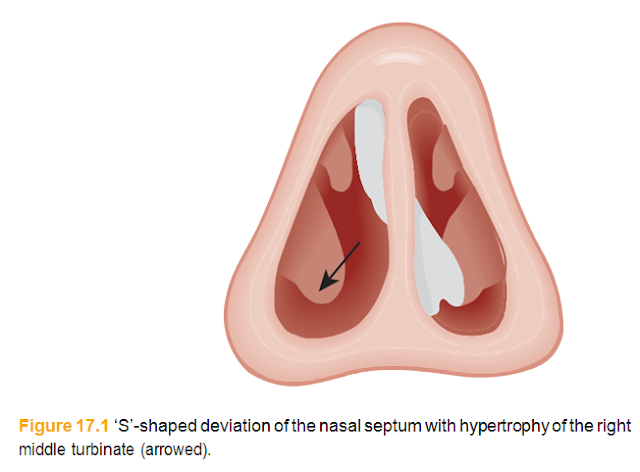The nasal septum is made up of bone and cartilage. It can be deviated,perforated, or collapsed.
Septal deviation
The nasal septum is rarely exactly in the midline (Fig. 17.1). Minor deviations are normal and cause no symptoms. Marked deviation will cause nasal airway obstruction and may contribute to sinonasal pathology by obstructing the normal sinus drainage pathways. Septal deviation can be corrected by surgery, with excellent results.
Aetiology
Most cases of deviated nasal septum (DNS) result from trauma, either recent or long forgotten, perhaps during birth. ‘Buckling’ in children may become more pro- nounced as the septum grows. Nasal surgery, including cosmetic surgery, can cause septal deviation.
Effects
• Nasal obstruction – may be unilateral or bilateral. • Recurrent sinus infection due to impairment of sinus ventilation by the displaced septum. The middle turbinate on the concave side of the septum may hypertrophy and interfere with sinus ventilation. • Severe deviation is apparent on looking at the nose and septal surgery is an impor- tant component of aesthetic nasal surgery (septorhinoplasty). • Can cause facial pain but this is rare. • Otitis media. DNS may impair the ability to equalize middle-ear pressure. • Nosebleeds – a sharp spur can be a focus for epistaxis (Fig. 17.2).
Treatment
If symptoms are minimal and there is only a minor degree of deviation, no treatment is needed. Septal deviations are often found in patients with allergic rhinitis. Treat the rhinitis rather than the septal deviation. Where symptoms are more severe correction of the septal deformity is justified (though never essential).
• Surgery involves elevating mucosal flaps from the septal cartilage and resecting part of the deviated cartilage before replacing it in the midline (septoplasty;Fig. 17.3).
• Septal surgery should be undertaken with caution if at all in children as it may interfere with the growth of the mid-face.
Septal perforation (Fig. 17.4)
Aetiology
Perforation of the nasal septum may result from the following conditions:
• Nasal surgery.
• Trauma including repeated nose-picking.
• Chronic inflammation, e.g. nasal granulomatosis, syphilis.
• Inhalation of fumes, e.g. chrome salts.
• Cocaine.
• Carcinoma.
Effects
Many septal perforations cause no trouble. They may give rise to epistaxis and crust- ing or rarely whistling on inspiration or expiration. A perforation is readily seen and often has unhealthy edges covered with large crusts.
Treatment
• Septal perforations are very difficult to repair.
• Nasal douching with saline or bicarbonate solution reduces crusting around the edge of the defect. • Antiseptic cream will help control infection. Be careful with creams based on peanut oil, e.g. Naseptin TM, as they can cause severe reactions in patients with peanut allergy. • A self-retaining double-flanged silastic button can be inserted into the perforation. • If crusting and bleeding remain a problem, the perforation can be closed surgically.
Septal collapse (saddle nose) (Fig. 17.5)
The cartilaginous septum can necrose following repeated trauma, an untreated nasal septal haematoma, or after extensive nasal surgery. Some chronic inflam- matory conditions, e.g. nasal granulomatosis, syphilis, and tuberculosis can cause septal necrosis with ‘saddling’. Patients complain of the aesthetic deformity and may also get very troublesome nasal obstruction. Treatment is difficult and may require extensive surgery to both the cartilage and the nasal bones– ‘augmentation septorhi- noplasty’.









ليست هناك تعليقات:
إرسال تعليق
من فضلك اكتب تعليقا مناسبا